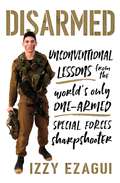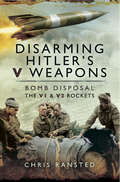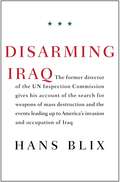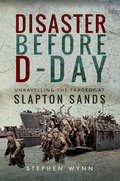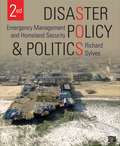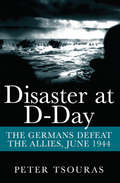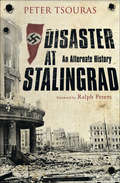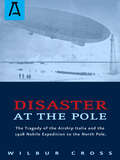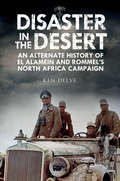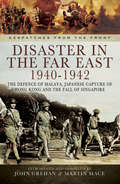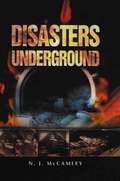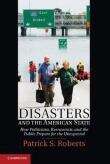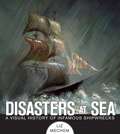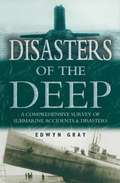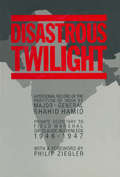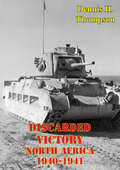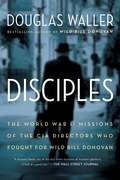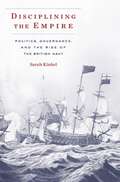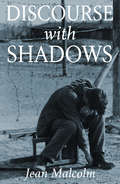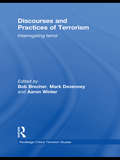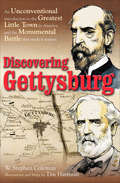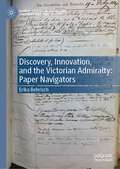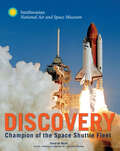- Table View
- List View
Disarmed by Love (Changing Tides #3)
by Gail ChianeseA Navy man with a damaged past. A beautiful woman enlisted to help him. Falling in love is the healing they both need. But it comes with a risk neither expected . . . When Fiona Sinclair’s reckless ex-husband piles on the anxiety, the resilient single mom has the perfect outlet: her days spent whipping Navy men into shape through yoga, meditation, and—as one of her new students puts it—“all that New Age crap.” For seventeen years, Lieutenant Dante Torres disarmed explosives. Stress level: over the top. Then one wrong move scrambled his brain. But nothing compares to dealing with a no-nonsense pint-sized fireball like Fiona. He has to admit, she’s working wonders. In more ways than one. As things warm between them, Dante even discovers he can be of help to her: by becoming best buddy to her troubled young son. But when the boy’s father pushes for custody, everything Fiona’s worked so hard for is thrown into jeopardy, including her relationship with Dante. Now it’s going to take all her resolve to fight back—for herself, her son, and the man she loves.
Disarmed: Unconventional Lessons from the World's Only One-Armed Special Forces Sharpshooter
by Izzy EzaguiThe inspiring story of a young American who volunteered to fight in the Israel Defense Forces, lost his arm in combat, and then returned to the battlefield.Combining refreshing candor with self-deprecating wit, this inspiring memoir will encourage readers to live up to their aspirations despite seemingly impossible odds.On January 8, 2009, Izzy Ezagui--an American who had enlisted in the Israel Defense Forces (IDF) at nineteen--lost his arm in a mortar attack on the border of the Gaza Strip. In this stirring and wryly humorous memoir, Izzy recounts his tortuous trek through rehabilitation to re-enlistment as a squad commander in the IDF. He became the world's only one-armed Special Forces sharpshooter.This isn't a typical war chronicle, full of macho bluster and the usual hero tropes. Izzy wrote this book with his fellow millennials in mind--not necessarily those with military ambitions, but everyone facing life's daily battles. His message is universal: if a self-described "nerd" and "one-armed basket case" like him can accomplish what he set his mind to, then anyone can become a hero in his or her own life.Growing up in a religious household in Miami, Izzy's early life was plagued by self-doubt, family drama, and (far too few) girl troubles. His search for direction eventually led him to that explosion on the Gaza border, changing his life forever.In the midst of disaster, Izzy discovered a deep well at his core, from which he could draw strength. Through his motivational speeches across the world, and now through this book, he encourages people to seek their own power, and to face whatever adversity life throws at them.
Disarming Hitlers V Weapons: Bomb Disposal, the V1 and V2 rockets
by Chris RanstedAn account of the &“brave men of the bomb disposal units who died disarming the weapons that Hitler hoped would save the Nazis from defeat&” (Dover Express/Folkestone Herald). In 1944 the V-1s and V-2s, Hitler&’s &“vengeance&” weapons, were regarded by the Allied leaders in London as the single greatest threat they had faced. It was feared that these flying bombs and rockets might turn the tide of war once again in Germany&’s favor. Yet, little more than half of these missiles hit their targets, some failing to explode. Their wreckage lay across the southern half of England or in Europe, with contents liable to sudden and deadly ignition. It was the job of specialist Bomb Disposal teams to render the V-weapons safe and uncover their secrets. This is their story. In this unique book Chris Ransted has investigated the work of these unsung heroes who risked their lives every time they were called into action and, in the course of his research he has located the sites of many of the unexploded V-weapons, revealed here for the first time. Ransted also details the methods used by the Bomb Disposal men and the equipment they used. The book is richly illustrated with 266 photographs and diagrams, many of which have never previously been published. In completing this, the most comprehensive study of its kind, the author describes the deeds of those gallant Bomb Disposal men that were awarded one of the highest honors which could have been bestowed upon them by their country—the George Medal. &“A particularly thorough and enlightening book.&”—Military Vehicle Trust
Disarming Iraq
by Hans BlixThe war against Iraq divided opinion throughout the world and generated a maelstrom of spin and counterspin. The man at the eye of the storm, and arguably the only key player to emerge from it with his integrity intact, was Hans Blix, head of the UN weapons inspection team.This is Dr. Blix’s account of what really happened during the months leading up to the declaration of war in March 2003. In riveting descriptions of his meetings with Tony Blair, Jacques Chirac, Colin Powell, Condoleezza Rice, and Kofi Annan, he conveys the frustrations, the tensions, the pressure and the drama as the clock ticked toward the fateful hour. In the process, he asks the vital questions about the war: Was it inevitable? Why couldn’t the U.S. and UK get the backing of the other member states of the UN Security Council? Did Iraq have weapons of mass destruction? What does the situation in Iraq teach us about the propriety and efficacy of policies of preemptive attack and unilateral action?Free of the agendas of politicians and ideologues, Blix is the plainspoken, measured voice of reason in the cacophony of debate about Iraq. His assessment of what happened is invaluable in trying to understand both what brought us to the present state of affairs and what we can learn as we try to move toward peace and security in the world after Iraq.
Disaster Before D-Day: Unravelling the Tragedy at Slapton Sands
by Stephen Wynn&“An eye-opening exposé of the Pre-D-Day disaster and incident of friendly fire tragedy and cover up that was the Slapton Sands.&” —WorldWars.com This is a book of two stories. The first is the sad tale of how at least 749 American servicemen lost their lives on a pre-D-Day landing exercise, code-named &“Operation Tiger,&” on the evening of 23/24 April 1943. The second, was the unanswerable question of whether the attacking E-Boats of the German Kriegsmarine had fully grasped the importance of what they had stumbled across. Because of the time scale between the operation and the actual D-Day landings, secrecy surrounding the tragedy had to be stringently adhered to, and even after the invasion of Normandy, only scant information about the incident and those who were killed was ever released. The other factor that was of major concern, was if the Germans had understood the significance of the vessels they had attacked, then the intended Allied invasion of Europe was in grave danger of having to be postponed for an indefinite period of time. In late 1943, as part of the buildup to the D-day landings at Normandy, the British government had set up a training ground at Slapton Sands in Devon, to be used by the American forces tasked with landing on Utah Beach in Normandy. Coordination and communication problems between British and American forces, resulted in friendly fire deaths during the exercise, making a bad situation even worse. The story was then lost to history until Devon resident, Ken Small, discovered evidence of the aftermath washed up on the shore at Slapton Sands in the early 1970s.
Disaster Policy and Politics: Emergency Management and Homeland Security (2nd Edition)
by Richard SylvesDisasters and emergencies challenge people and their governments. Americans routinely want to know how government officials performed during and after events such as the 9/11 terror attacks of 2001; Hurricane Katrina in 2005; the British Petroleum (BP) Deepwater Horizon oil spill in 2010; the Tuscaloosa, Alabama, and Joplin, Missouri tornadoes of 2011
Disaster at D-Day: The Germans Defeat the Allies, June 1944 (Military Paperbacks Ser.)
by Peter TsourasThe editor of Hitler Triumphant combines history and fiction to craft an alternative history of the Normandy landings on D-Day. It is June, 1944. The Allied armies are poised for the full-scale invasion of Fortress Europe. Across the Channel, the vaunted Wehrmacht lies waiting for the signs of invasion, ready for the final battle . . . What happens next is well-known to any student of modern history. The outcome could easily have been very different, as Peter Tsouras shows in this masterful and devastating account in which plans, missions, and landings go horribly wrong. Tsouras firmly bases his narrative on facts but introduces minor adjustments at the opening of the campaign—the repositioning of a unit, bad weather and misjudged orders—and examines their effect as they gather momentum and impact on all subsequent events. Without deviating from the genuine possibilities of the situation, he presents a scenario that keeps the reader guessing and changes the course of history.Praise for Disaster at D-Day&“A brilliant and interesting book. The author has pulled off a great feat of imagination and research.&” —Military Illustrated&“This should find a place on the shelves of anyone with an interest in the period and would be invaluable background reading in preparation for a battlefield tour of Normandy.&” —The British Army Review
Disaster at Stalingrad: An Alternate History
by Peter TsourasA fascinating &“what if&” history of one of World War II&’s most iconic battles. It is early September 1942 and the German commander of the Sixth Army, General Paulus, assisted by the Fourth Panzer Army, is poised to advance on the Russian city of Stalingrad. His primary mission was to take the city, crushing this crucial center of communication and manufacturing, and to secure the valuable oil fields in the Caucasus. What happens next is well known to any student of modern history: a brutal war of attrition, characterized by fierce hand-to-hand combat, that lasted for nearly two years, and the eventual victory by a resolute Soviet Red Army. A ravaged German Army was pushed into full retreat. This was the first defeat of Hitler&’s territorial ambitions in Europe and a critical turning point of World War II. But the outcome could have been very different, as Peter Tsouras demonstrates in this fascinating alternate history of this fateful battle. By introducing minor—and realistic— adjustments, Tsouras presents a scenario in which the course of the battle runs quite differently, which in turn throws up disturbing possibilities regarding the outcome of the whole war.
Disaster at the Pole: The Tragedy of the Airship Italia and the 1928 Nobile Expedition to the North Pole
by Wilbur CrossThe true story of the harrowing wreck of the airship Italia during a polar expedition and the heroic rescue attempts to save her and her crew. This is an intriguing and heart-stopping account of the tragic aviation disaster of Commander Umberto Nobile, an Italian aeronautic engineer and airship designer, as he led an expedition to cross the North Pole in the dirigible airship, Italia. Nobile and Norwegian explorer Roald Amundsen had previously led the first successful trip across the North Pole from Europe to America in the airship Norge, beating the attempts by American explorer Admiral Richard Byrd, during history's exciting period known as the Golden Age of Aviation. During an artic storm, the Italia suddenly crashed on an ice pack and the crew was stranded, leading to one of the world's greatest international search and rescue efforts, involving countries such as Russia, Norway, Italy, France and Great Britain.The story is both of the tremendous efforts and heroism of the many search and rescue expeditions, including internationally famous artic explorer Roald Amundsen, who was never seen again, as well as the courage and determination of Nobile and the Italia crew as they battled the elements of the polar ice fields for survival. The event also stirred international politics as Nobile was a well-known opponent to Mussolini's fascist regime and Mussolini is said to have thwarted the successful rescue of Nobile and his crew.In researching this book, author Cross personally went to Italy and interviewed Umberto Nobile as well as nine other survivors from the crash. He also worked with and interviewed the officers at the Norwegian airbase from which the Italia flew on its fatal flight. Additional information came from the Dartmouth University Institute of Artic Studies, including interviews with renowned artic explorer Vilhjalmur Stefansseon, who personally knew General Nobile.
Disaster in the Desert: An Alternate History of El Alamein and Rommel's North Africa Campaign
by Ken DelveFor fans of Philip K. Dick and Harry Turtledove, a World War II alternate history novel that imagines a victory for Germany&’s Rommel in North Africa. Summer 1942, and the war in the Middle East is in the balance. Rommel&’s Axis forces are poised on the borders of Egypt and all that is needed is one last push. For that to succeed, Rommel needs supplies and for the Allies to be denied supplies. With Malta still active and disrupting the Axis shipping routes across the Mediterranean he is denied those supplies. Meanwhile, the Allied build-up continues, and Montgomery holds at El Alamein and then counter attacks. Rommel is pushed back and then, in a double blow, the Allies land in Tunisia. The collapse of North Africa leads to the invasion of Italy and contributes to the final Axis defeat. But what if Rommel had won? In this alternate history, Ken Delve proposes that with a few strategic changes by the Axis powers and poor decision by Allied Commanders, the outcome of could have been very different. In this scenario, the Allied invasion in Tunisia fails, Rommel defeats Montgomery and seizes Egypt, leaving the Germans well-placed to sweep up through the Middle East, capturing oil installations and joining up with German forces in Russia.
Disaster in the Far East, 1940–1942: Disaster In The Far East 1940- 1942
by Martin Mace John GrehanDespatches in this volume include that on the Far East between October 1940 and December 1941, by Air Chief Marshal Sir Robert Brooke-Popham; the despatch on operations in Hong Kong between 8 and 25 December 1941, by Major-General C.M. Maltby, General Officer Commanding British Troops in China; the report on the air operations during the campaigns in Malaya and Netherland East Indies between December 1941 and March 1942; and the important despatch by Percival detailing the fall of Malaya and Fortress Singapore.This unique collection of original documents will prove to be an invaluable resource for historians, students and all those interested in what was one of the most significant periods in British military history.
Disasters Underground
by N. J. McCamleyThe rapid expansion of the RAF during the mid/late 1930s necessitated a massive storage requirement for high explosive bombs and other ordinance. Drawing on the experience of the Great War ammunition factories, the authorities set about identifying underground sites around Britain safe from the threat of air attack. Unfortunately in the haste of the moment safety arrangements were not a high priority and, as a result, there were a number of appalling accidents; the most serious occurred in November 1944 when 3,800 tons of HE bombs detonated at the same time resulting in the deaths of 68 people in a Staffordshire quarry.
Disasters and the American State
by Patrick S. RobertsDisasters and the American State offers a thesis about the trajectory of federal government involvement in preparing for disaster shaped by contingent events. Politicians and bureaucrats claim credit for the government's successes in preparing for and responding to disaster, and they are also blamed for failures outside of government's control. New interventions have created precedents and established organizations and administrative cultures that accumulated over time and produced a general trend in which citizens, politicians and bureaucrats expect the government to provide more security from more kinds of disasters. The trend reached its peak when the Federal Emergency Management Agency adopted the idea of preparing for 'all hazards' as its mantra. Despite the rhetoric, however, the federal government's increasingly bold claims and heightened public expectations are disproportionate to the ability of the federal government to prevent or reduce the damage caused by disaster.
Disasters at Sea: A Visual History of Infamous Shipwrecks
by Liz MechemA fully illustrated collection of the most thrilling shipwrecks of all time!Experience the mystery and wonder of the bottom of the sea with over sixty accounts of shipwreck catastrophes. Illustrated with detailed maps and shipwreck locations, Disasters at Sea takes readers on a fascinating journey through history and to the ocean floor. Learn all about the historical details and theories of the most infamous shipwrecks--from the most well-known sinkings like the Titanic, to the obscure, mysterious drifting ghost ships and unexplained disappearances. Subjects include:* Tragedies by Mother Nature* Shipwrecks and war* Fatal errors* Legends, myths, mysteries* And many more!Whether by human error, collision, piracy, or mutiny, this book has them all. With shipwrecks from the Old Testament, to ancient Greece, to modern times, this exciting book is compellingly written with accompanying sources, high-quality images, and a great deal of evidence. Find out interesting tidbits about Christopher Columbus's Santa Maria, which eluded discovery for centuries despite long-term investigations. Stay afloat with the Mary Celeste and the Carroll A. Deering--ships that did not wreck at all but whose entire crews disappeared, never to be found. Readers are no doubt familiar with the tragedy of the Titanic, but this book also recounts the Wilhelm Gustloff, which took nine thousand lives at the end of World War II.Disasters at Sea is sure to offer an addicting and thrilling voyage that will leave you reading over and over again. This is an exciting book for the history buff--or for anyone looking for a fascinating read!
Disasters of the Deep: A Comprehensive Survey of Submarine Accidents & Disasters
by Edwyn GrayThe comprehensive reference to peacetime submarine disasters, updated with now-declassified Cold War events, the Kursk tragedy, and more.This is the fully revised and updated edition of the first comprehensive account of every peacetime submarine disaster from 1774 to the twenty-first century tragedy of the Kursk. By examining many of the sinkings in considerable detail, analyzing what went wrong, and describing the attempts made to rescue the crew and the vessel, Edwyn Gray traces the development of the submarine from the earliest experimental submersibles of the late eighteenth century to the nuclear-powered monsters of today. The appendices include the most comprehensive and accurate list of submarine disasters ever printed, in the compilation of which the author has had the cooperation of the US, French, Italian, Danish, and Japanese navies, as well as the RN Submarine Museum and the German U-Boat Archive.“An invaluable reference book for naval historians and also a most fascinating read for the layman.” —Journal of Military and Veterans’ HealthPublished in a previous edition as Few Survived
Disastrous Twilight: A Personal Record of the Partition of india by Major-General Shahid Hamid
by Shahid AmidThe Partition of India in 1947 probably created more problems than it solved, problems which have bedevilled the subcontinent ever since and which show no sign of going away, since those who feel that they were hard done by at the time of the settlement nearly forty years ago harbour their grudges as fiercely as ever and clearly have no intention of accepting- their lot with equanimity in the foreseeable future. Any new assessment of the Partition is therefore doubly welcome - both as a contribution to history and as an aid to an understanding of what, in current jargon, is still very much an "on-going situation". General Hamid's book is of particular value in view of the unique vantage point from which it was written. In 1946 he was appointed Personal Secretary to Field-Marshal Sir Claude Auchinleck, then Commander-in-Chief, India. Realising that he had the good fortune to have been given a ringside seat for possibly the greatest of all the dramas in his country's history. Hamid decided to keep a diary which is only now being published because the author was made to promise that it would appear during the Auk's lifetime, a gesture typical of that very great and good but essentially private man. Hamid was in constant contact with all those people the sum of whose decisions were to lead to one of the greatest mass migrations, accompanied by one of the greatest mass migrations, accompanied by one of the greatest bloodbaths in the history of mankind. His observations on the build-up to this appalling tragedy have the added value of being untainted by hindsight, and though many may not agree with all his opinions, few will deny that the views he expressed at the time have stood up to the judgement of history remarkably well.
Discarded Victory - North Africa, 1940-1941
by Dennis H. ThompsonThe Anglo-Italian campaign of 1940-41 resulted in one of the most lopsided operational victories of the entire Second World War. Strategic misjudgement at the highest levels of British political and military leadership would discard the opportunities won by its fighting forces in North Africa and commit them to a catastrophic intervention in Greece. In 1940, Italy fielded a numerically overwhelming, but technologically deficient, conscript military force on the continent of Africa. Italy’s political leaders expected her 500,000 strong North African army to quickly defeat the British troops stationed in the theater of operation. The British forces, though inferior in numbers, were well-trained regulars who possessed more superior weaponry than their Italian foes. In the brief, high intensity conflict waged in the North African deserts from December 1940 to February 1941, the British would annihilate an Italian army of 130,000 soldiers. On the verge of complete victory in the North African theater, the British would commit an act of extraordinary strategic misjudgement and divert their efforts to Greece in order to engage the Axis forces on the continent of Europe. The discarded early victory in North Africa would lead Britain to catastrophe in Greece, cost them the initiative in the war, and nearly led to their defeat in North Africa.
Disciples: The World War II Missions of the CIA Directors Who Fought for Wild Bill Donovan
by Douglas WallerThe author of the critically acclaimed bestseller Wild Bill Donovan, tells the story of four OSS warriors of World War II. All four later led the CIA.They are the most famous and controversial directors the CIA has ever had--Allen Dulles, Richard Helms, William Colby, and William Casey. Disciples is the story of these dynamic agents and their daring espionage and sabotage in wartime Europe under OSS Director Bill Donovan. Allen Dulles ran the OSS's most successful spy operation against the Axis. Bill Casey organized dangerous missions to penetrate Nazi Germany. Bill Colby led OSS commando raids behind the lines in occupied France and Norway. Richard Helms mounted risky intelligence programs against the Russians in the ruin of Berlin after the German surrender. Four very different men, they later led (or misled) the successor CIA. Dulles launched the calamitous operation to land CIA-trained, anti-Castro guerrillas at Cuba's Bay of Pigs. Helms was convicted of lying to Congress about the CIA's effort to oust Chile's president. Colby would become a pariah for releasing to Congress what became known as the "Family Jewels" report on CIA misdeeds during the 1950s, sixties and early seventies. Casey would nearly bring down the CIA--and Ronald Reagan's presidency--from a scheme to secretly supply Nicaragua's contras with money raked off from the sale of arms to Iran for American hostages in Beirut. Mining thousands of once-secret World War II documents and interviewing scores of family members and CIA colleagues, Waller has written a brilliant successor to Wild Bill Donovan.
Disciplining the Empire: Politics, Governance, and the Rise of the British Navy (Harvard historical studies ; #v. 189)
by Sarah Kinkel“Rule Britannia! Britannia rule the waves,” goes the popular lyric. The fact that the British built the world’s greatest empire on the basis of sea power has led many to assume that the Royal Navy’s place in British life was unchallenged. Yet, as Sarah Kinkel shows, the Navy was the subject of bitter political debate. The rise of British naval power was neither inevitable nor unquestioned: it was the outcome of fierce battles over the shape of Britain’s empire and the bonds of political authority. Disciplining the Empire explains why the Navy became divisive within Anglo-imperial society even though it was also successful in war. The eighteenth century witnessed the global expansion of British imperial rule, the emergence of new forms of political radicalism, and the fracturing of the British Atlantic in a civil war. The Navy was at the center of these developments. Advocates of a more strictly governed, centralized empire deliberately reshaped the Navy into a disciplined and hierarchical force which they hoped would win battles but also help control imperial populations. When these newly professionalized sea officers were sent to the front lines of trade policing in North America during the 1760s, opponents saw it as an extension of executive power and military authority over civilians—and thus proof of constitutional corruption at home. The Navy was one among many battlefields where eighteenth-century British subjects struggled to reconcile their debates over liberty and anarchy, and determine whether the empire would be ruled from Parliament down or the people up.
Discourse with Shadows
by Jean Eileen MalcolmDiscourse with Shadows, first published in 1958, is a stark, yet compassionate look at the lives of four Nazi concentration camp survivors and of a friend who returns to Frankfurt from England to locate a missing relative and her son Johann. Driven by their long-repressed anger, the group carries out the murder of a Nazi woman who often attended the tortures at the concentration camp; dire consequences follow which threaten the group of friends.From the dustjacket: The scene is Frankfurt at the late war’s end: living there are four survivors of a Nazi concentration camp—and Franz Grünwald, who has spent the years since 1935 in England and has now returned to his former home town in search of a relative. We shall only add that the author displays here—in a first novel—such a power of sympathetic imagination as seems to us quite extraordinary. This is an extremely moving book; and while terror and wickedness are never far away, and no attempt is made to see things other than as they are, the total effect given is not only of compassion but also of beauty.
Discourses and Practices of Terrorism: Interrogating Terror (Routledge Critical Terrorism Studies)
by Bob BrecherThis interdisciplinary book investigates the consequences of the language of terror for our lives in democratic societies. The approach of this book is in direct contrast with those that either view terrorism simplistically, as a clear reality threatening democratic society and thus requiring certain sorts of response, or argue, equally simplistically, that the invocation of terror is merely the ideological veil for continued capitalist exploitation. While closer in spirit to the second of these, this work does not simply dismiss the discourse on terror, but rather investigates the consequences of this discourse for the organisation of life in democratic societies. In interrogating the discourse of terror from a variety of viewpoints, this interdisciplinary text builds upon the understanding of the importance of the language of terror from a new perspective: the interconnections between discourses of terror; the material realities they at once reflect and help produce; and the specificities of particular historical circumstances. In offering an integrated approach of this sort, and founded on a base of applied philosophy, broadly conceived, the contributors offer a new contribution to both public and academic debate, and at the same time initiate a series of further interventions in Critical Terrorism Studies. This book will be of interest to students of critical terrorism studies, terrorism studies, security studies, philosophy and discourse theory. Bob Brecher is Director of the Centre for Applied Philosophy, Politics & Ethics at Brighton University. He has published widely in moral, political and applied philosophy and the politics of higher education. Mark Devenney is Academic Programme Leader in Humanities at the University of Brighton. He has published in the areas of critical theory, post-Marxism and post-Colonial politics. Aaron Winter is Lecturer in Sociology at the University of Abertay Dundee. His research focuses on terrorism and the concept of ‘extremism’, whiteness, masculinity and violence, and the extreme right, organised racism and the religious right in the United States.
Discover Ancient Egypt: Level 2 Reader (Discover Reading)
by Amanda TraneMonkey Fun! proves that you’re never too young to begin your learning adventure. It’s a barrel of fun and chock full of interesting monkey facts written in easy to understand rhyming verse for toddlers ages 0-4. “That’s not a monkey who’s peeling a grape. Bigger and tailless, he must be an ape.” “Monkeys who live in a family group, travel together and share with their troop.” Bold, colorful illustrations by Aida Barba Flores will capture the attention of young readers and aid in story comprehension. This is an edutaining rhyming adventure that offers fun learning resources in the back of the book including, Mrs. Dweck’s monkey facts and a monkey counting game.
Discovering Gettysburg: An Unconventional Introduction to the Greatest Little Town in America and the Monumental Battle that Made It Famous
by W. Stephen Coleman Tim HartmanGettysburg.Does any other single word in any language invoke so much passion and angst, enthusiasm and sadness, as do those ten letters? But what IS Gettysburg, exactly? I am almost embarrassed to say I discovered the answer to that questionor at least approached an answeronly late in life.Of course, Gettysburg is a small charming city nestled in south-central Pennsylvania, but in so many ways it beggars description. For about half the year its streets are mainly empty, its businesses quiet, the weather cold and blustery. For the other months, however, the place literally teems with hundreds of thousands of visitors, bustling streets and shops, and more than a handful of unique larger-than-life characters whose fan base spans the globe.And then there is the battlethe eventof the Civil War. The battle that raged there during the first days of July 1863 at the price of more than 50,000 casualties decided much (just how much depending upon who you believe) and forever stamped that place with its passion and angst and enthusiasm and its lingering, forever sadness. Its monuments and guns and plaques tell the story of the colossal clash of arms and societies, just as its National Cemetery bears silent witness to at least part of the cost of that bloody event.And somehow this greatest little town in America, this mammoth battle, its influential characters (living and dead), its deep meaning and profound influence on our society largely escaped me for nearly six decades. That ended a couple years ago when I finally paid a visit. My journey from the uninitiated to the fully converted only took a short time, but I felt compelled to pen my experiences as they unfolded. And so you hold in your hands Discovering Gettysburg: An Unconventional Introduction to the Greatest Little Town in America and the Monumental Battle that Made It Famous.In it, you will visit with me a host of famous and off-the-beaten-path places on the battlefield, explore the historic town of Gettysburg as it is today, chat with some of the towns fascinating resources, and follow along, as I did, with some of the most engaging storytelling I have ever had the pleasure of hearing. And nowhere inside will you be bothered with footnotes or stumble your way through academic mumbo jumbo. Thankfully, my friend and award-winning cartoonist Tim Hartman agreed to provide the magnificent maps and outstanding caricatures that grace this book.Discovering Gettysburg is, I fully admit, rather unconventional. But so is the place, the event, and the experience of that hallowed ground.
Discovery, Innovation, and the Victorian Admiralty: Paper Navigators (Global Studies in Social and Cultural Maritime History)
by Erika BehrischThis book examines the British Admiralty’s engagement with science and technological innovation in the nineteenth century. It is a book about people, and gross misunderstanding, about the dreams and disappointments of scientific workers and inventors in relation to the administrators who adjudicated their requests for support, and about the power of paper to escalate arguments, reduce opinions, and frustrate hopes. From instructions for naval surveying to debates about rewards to civilians for inventions, Paper Navigators puts a wide range of primary sources in the context of public debates and explores the British Admiralty’s engagement with, decision-making around, and management of questions of value, support, and funding with citizen inventors, the broader public, and their own employees. Concentrating on the Admiralty’s private, internal correspondence to explore these themes, it offers a fresh perspective on the Victorian Navy's history of innovation and exploration and is a novel addition to literature on the history of science in the nineteenth century.
Discovery: Champion of the Space Shuttle Fleet
by Valerie NealThis book places Space Shuttle Discovery within the history of the space shuttle program and provides an introduction to space shuttle technology, with a focus on the orbiter itself. Discovery's unique history is presented mission by mission that includes a brief narrative of each mission, a chart of its key statistics (dates, duration, altitude, payloads, etc.), each mission's patch with an explanation of its unique symbolism, a crew portrait, and two to four iconic photos that capture the distinct activities and successes of each mission. The book also features anecdotes and memories of several astronauts who flew on Discovery, as well as its modernization over the years and its final preparation for retirement at the Smithsonian.

